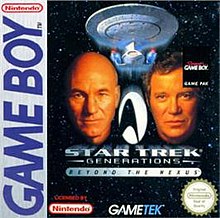
Star Raiders is a first-person space combat simulator for the Atari 8-bit family of computers. It was written by Doug Neubauer, an Atari employee, and released as a cartridge by Atari in March 1980. The game is considered the platform's killer app. It was later ported to the Atari 2600, Atari 5200, and Atari ST.

Star Trek Generations is a 1997 first-person shooter with adventure and strategy elements by MicroProse, based on Star Trek Generations (1994), the seventh film in the Star Trek film franchise. It includes voice-acting by actors Patrick Stewart and Malcolm McDowell, as well as footage from the film.
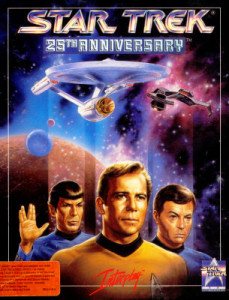
Star Trek: 25th Anniversary is an adventure video game developed and published by Interplay Productions in 1992, based on the Star Trek universe. The game chronicles various missions of James T. Kirk and his crew of the USS Enterprise. Its 1993 sequel, Star Trek: Judgment Rites, continues and concludes this two-game series, which together may be seen as the final two years of the USS Enterprise's five-year mission.
Spasim is a 32-player 3D networked space flight simulation game and first-person space shooter developed by Jim Bowery for the PLATO computer network and released in March 1974. The game features four teams of eight players, each controlling a planetary system, where each player controls a spaceship in 3D space in first-person view. Two versions of the game were released: in the first, gameplay is limited to flight and space combat, and in the second systems of resource management and strategy were added as players cooperate or compete to reach a distant planet with extensive resources while managing their own systems to prevent destructive revolts. Although Maze is believed to be the earliest 3D game and first-person shooter as it had shooting and limited multiplayer by fall 1973, Spasim has been considered along with it to be one of the "joint ancestors" of the first-person shooter genre, due to uncertainty over Maze's development timeline.

Star Trek: Away Team is an isometric real-time tactics video game developed by Reflexive Entertainment and published by Activision. The game was initially released in March 2001 for personal computers using Microsoft Windows in North America. The game is set in the Star Trek universe, after the end of the Dominion War seen in the television series Star Trek: Deep Space Nine. It features a range of new characters, set on board the USS Incursion with voice appearances by Brent Spiner and Michael Dorn as Lieutenant Commander Data and Ambassador Worf, respectively. The game received mixed reviews, with criticism directed at the graphics, elements of the gameplay including the lack of any artificial intelligence, and the limited length of the game.

Batman Returns is a 1992 beat 'em up video game for various platforms based on the film of the same name. The Sega console versions were published by Sega while the NES and Super NES versions were developed and published by Konami. The MS-DOS and Amiga versions were also published by Konami, but were developed by Spirit of Discovery and Denton Designs respectively. An Atari ST version by Konami was also advertised, but never released. There is also an Atari Lynx version, published by Atari Corporation.

Red Alarm is a 1995 shoot 'em up video game developed by T&E Soft and published by Nintendo. Released as a Virtual Boy launch game, it requires the player to pilot a space fighter and defeat the army of a malevolent artificial intelligence called "KAOS". The game takes inspiration from the 1993 title Star Fox, and it is one of the few third-party titles for the Virtual Boy. Unlike most of the console's games, Red Alarm features three-dimensional (3D) polygonal graphics. However, hardware constraints limited the visuals to bare wire-frame models, similar to those of the 1980 arcade game Battlezone. Reviewers characterized Red Alarm's graphics as confusing, but certain publications praised it as one of the most enjoyable Virtual Boy titles.

There have been several video games based on the 1991 film Hook. A side-scrolling platform game for the Nintendo Entertainment System (NES) and Game Boy was released in the United States in February 1992. Subsequent side-scrolling platform games were released for the Commodore 64 and the Super Nintendo Entertainment System (SNES), and an arcade beat ‘em up by Irem later in 1992, followed by versions for the Sega CD, Sega Genesis, and Sega's handheld Game Gear console in 1993.
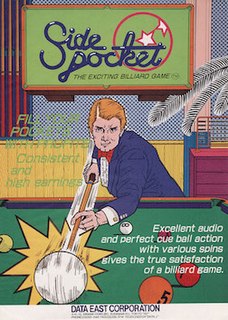
Side Pocket is a pocket billiards sports video game originally released into arcades by Data East in 1986. The arcade version was eventually ported to the Nintendo Entertainment System and Game Boy, while an enhanced remake was later released on the Sega Genesis, Super Nintendo Entertainment System, and the Sega Game Gear. The game also spawned two sequels, as well as arcade spin-off series titled Pocket Gal.

The Lion King is a platform game based on Disney's 1994 animated film The Lion King. The game was developed by Westwood Studios and published by Virgin Interactive Entertainment for the Super NES and Genesis in 1994, and was ported to MS-DOS, Amiga, Game Gear, Master System, and Nintendo Entertainment System. The Amiga, Master System, and NES versions were only released in the PAL region. It is the final licensed NES game worldwide. The game follows Simba's journey from a young cub to the battle with his uncle Scar as an adult.

Star Trek: The Next Generation is a 1994 adventure game developed and published by Spectrum HoloByte. The game features strategy and puzzle-solving elements. The game was released for the Super Nintendo Entertainment System, the Sega Genesis and the Sega Game Gear. It takes place in the Star Trek universe, spanning Federation space and the Romulan Neutral Zone, and centers on the appearance of the IFD, an artifact machine of unknown origin that, as its name suggests, allows its user to reshape matter and energy. It culminates in the IFD Trials, three tests undertaken by representatives of any races that are present when the Trials are held, and failure would mean the destruction of the Federation and the enslavement of countless worlds by the Federation's enemies.

Alien 3 is a run and gun video game based on the 1992 film of the same name. The game was released for the Sega Genesis and Amiga in 1992, with additional versions being released in 1993 for the Commodore 64, Game Boy, Game Gear, Nintendo Entertainment System (NES), Super Nintendo Entertainment System (SNES), and Master System.

Batman Forever is a beat 'em up video game based on the movie of the same name. Though released by the same publisher at roughly the same time, it is an entirely different game from Batman Forever: The Arcade Game. The game was followed by Batman & Robin in 1998, itself based on the movie of the same name.

True Lies is a top-view run and gun shooter based on the 1994 film True Lies. The game was developed by Beam Software and published by Acclaim Entertainment. Four different versions of the game were released for the Super Nintendo Entertainment System, Sega Genesis, Game Gear, and Game Boy. The home versions and portable versions are drastically different from each other, but have similar play mechanics.

Star Fighter or Star Fighter 3000 is a 3D flight-based shoot-em-up. The gameplay is mission based and involves elements of strategy and planning. The player can order wingmen to fly in formation and attack specific targets.
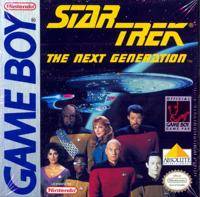
Star Trek: The Next Generation is a large spaceship simulation video game based on the Star Trek follow-up series of the same name. It was released in 1993 to the North American and European markets for both the Nintendo Entertainment System (NES) and Game Boy.

Star Trek: Voyager – Elite Force is a first-person shooter video game developed by Raven Software and published by Activision. The game was originally released on September 15, 2000 for Windows and Mac OS. Aspyr Media was responsible for porting the game to the Mac OS platform. Elite Force was ported to the PlayStation 2 by Pipe Dream Interactive and published by Majesco Entertainment on December 6, 2001.

Star Trek: Deep Space Nine – Crossroads of Time is a 1995 action-adventure video game for the Genesis and Super NES platforms, based on the television series Star Trek: Deep Space Nine. Critics praised the game's authentic recreation of the look and feel of the TV series, but often criticized its gameplay as repetitive and clunky.
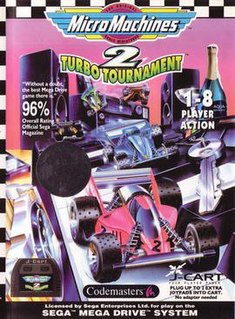
Micro Machines 2: Turbo Tournament is a 1994 racing video game developed by Supersonic Software and published by Codemasters for the Sega Mega Drive. The sequel to Micro Machines, the game is themed around Galoob's Micro Machines toys, and players race around environments in miniature toy vehicles. Micro Machines 2: Turbo Tournament adds new vehicles and game modes, and the Mega Drive version was released on J-Cart, enabling up to eight players without a multitap.
